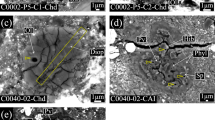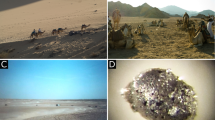Abstract
Chondrules and Ca, Al-rich inclusions (CAIs) are important constituents of chondritic meteorites which preserve a record of chemical fractionation at high temperature in the early solar nebula1. Cosmochemical research on these components of meteorites shows that chondrules were formed by melting of preexisting solid precursor materials2–4. Although highly fractionated rare-earth element (REE) patterns have been known for CAIs5,6 and are considered as evidence for high-temperature fractionation in the nebula7,8, little is known about refractory precursor components of chondrules. In addition, chondrules so far studied rarely exhibit fractionated REE patterns, except in a few cases9,10, so that no single variety of refractory precursor component can be invoked as the fractionated REE carrier in chondrules. Here we describe two ferromagnesian chondrules from the Felix (Ornans-subtype) carbonaceous chondrite which carry a marker signature of REE fractionation in the nebula. Both show positive Ce and Yb anomalies and one exhibits a light/heavy REE fractionation similar to those of Group II CAI6. On the basis of the REE characteristics of these chondrules, as well as those of Allende (CV) (ref. 11), we suggest that one of the precursor materials of chondrules in CO–CV carbonaceous chondrites is a high-temperature condensate from the nebular gas.
This is a preview of subscription content, access via your institution
Access options
Subscribe to this journal
Receive 51 print issues and online access
$199.00 per year
only $3.90 per issue
Buy this article
- Purchase on Springer Link
- Instant access to full article PDF
Prices may be subject to local taxes which are calculated during checkout
Similar content being viewed by others
References
Wood, J. A. A. Rev. Earth planet. Sci. 16, 53–72 (1988).
Nagahara, H. Nature 292, 135–136 (1981).
Rambaldi, E. R. Nature 293, 558–561 (1981).
Gooding, J. L., Keil, K., Fukuoka, J. & Schmitt, R. A. Earth planet. Sci. Lett. 50, 171–180 (1980).
Tanaka, T. & Masuda, A. Icarus 19, 523–530 (1973).
Martin, P. M. & Mason, B. Nature 249, 333–334 (1974).
Boynton, W. V. Geochim. cosmochim. Acta 39, 569–584 (1975).
Davis, A. M. & Grossman, L. Geochim. cosmochim. Acta 43, 1611–1632 (1976).
Bischoff, A., Spettel, B. & Palme, H. Meteoritics 20, 609–610 (1985).
Rubin, A. E. & Wasson, J. T. Geochim. cosmochim. Acta 51, 1923–1937 (1987).
Misawa, K. & Nakamura, N. Geochim. cosmochim. Acta (in the press).
Nakamura, N. Geochim. cosmochim. Acta 38, 757–775 (1974).
McSween, H. Y. Jr Geochim. cosmochim. Acta 41, 1843–1860 (1977).
McSween, H. Y. Jr, Fronabarger, A. K. & Driese, S. G. in Chondrules and their Origins (ed. King, E. A.) 195–210 (Lunar Planetary Institute, Houston, Texas, 1983).
Wark, D. A. Geochim. cosmochim. Acta 51, 221–242 (1987).
Gooding, J. L. & Keil, K. Meteoritics 16, 17–43 (1981).
Mason, B. & Martin, P. M. Smithson Contr. Earth Sci. 19, 83–95 (1977).
Mason, B. & Taylor, S. R. Smithson Contr. Earth Sci. 25, 1–30 (1982).
Iretand, T., Fahey, A., McKeegan, K. & Zinner, E. Meteoritics 21, 404–405 (1986).
Liu, Y.G., Rajan, R. S. & Schmitt, R. S. Lunar planet. Sci. XVIII, 562–563 (1987).
Niederer, F. R. & Papanastassiou, D. A. Geochim. cosmochim. Acta 48, 1279–1293 (1984).
Kornacki, A. S. & Fegley, B. Jr Proc. Lunar planet. Sci. Conf. 14, B588–B596 (1984).
Boynton, W. V. & Cunningham, C. C. Lunar planet. Sci. XI, 106–108 (1981).
Davis, A. M., Tanaka, T., Grossman, L., Lee, T. & Wasserburg, G. J. Geochim. cosmochim. Acta 46, 1627–1651 (1982).
Kornacki, A. S. & Fegley, B. Jr Earth planet. Sci. Lett. 79, 217–234 (1986).
Wood, J. A. Earth planet. Sci. Lett. 56, 32–44 (1981).
Bence, A. E. & Albee, A. L. J. geol. 76, 382–404 (1968).
Ikeda, Y. Mem. Nat. Inst. Polar. Res. Spec. Issue 17, 50–82 (1980).
Author information
Authors and Affiliations
Rights and permissions
About this article
Cite this article
Misawa, K., Nakamura, N. Highly fractionated rare-earth elements in ferromagnesian chondrules from the Felix (CO3) meteorite. Nature 334, 47–50 (1988). https://doi.org/10.1038/334047a0
Received:
Accepted:
Issue Date:
DOI: https://doi.org/10.1038/334047a0
This article is cited by
-
Fragments of history preserved
Nature (1994)
-
A relict refractory inclusion in a ferromagnesian chondrule from the Allende meteorite
Nature (1994)
-
Chondrites and the solar nebula
Nature (1988)
Comments
By submitting a comment you agree to abide by our Terms and Community Guidelines. If you find something abusive or that does not comply with our terms or guidelines please flag it as inappropriate.



